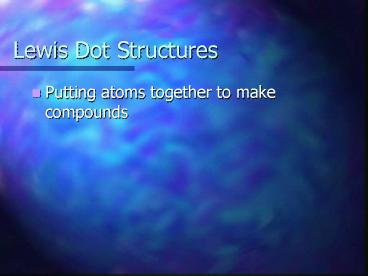Lewis Dot Structures PowerPoint PPT Presentation
1 / 16
Title: Lewis Dot Structures
1
Lewis Dot Structures
- Putting atoms together to make compounds
2
Single Atom Lewis Structures
- What do they look like? (instructor will draw one
on the board) - Procedure
- Write element symbol
- Add valence electrons (dots) around element
symbol - If valence electrons are paired in an orbital,
pair them on the structure, if not, dont (keep
them single) - Do Carbon on the board
- More Practice H, He, F, P, Mg, N, Kr
3
Lets Put Them Together!Ionic bonds (Salts!!!)
- Transfer of one or more electrons from one
species to anotherUsually A Metal Nonmetal - Can be combinations of Polyatomic Ions (will
explain these later) - They Make Ionic Lattices! LiF Li F-
- (Graphic on Next Slide)
4
A Lithium Fluoride Crystal
5
Another Representation of Crystals (aka Ionic
Lattices)
6
Ionic Lattices are also called Salts!
- The representative formulas are called Formula
Units (the simplest way to express what is in the
crystal). - Every element has to have 8 electrons (or 2 in
some casesmore about that later) when bonding
with another one. - We transfer dots (e-) from one Lewis Structure to
another to make Ionic Bonds. - Put every ion in brackets R and its charge
outside the brackets when finished. - Show example on board
7
Periodic Chart Charges
- (1) Alkali Metals1
- (2) Alkaline Earth Metals2
- (3-12) Transition MetalsMany Possible Chargesif
you do these, you will be given the charge to
use! - (13) Boron Family3
8
Periodic Chart Charges (cont)
- (14) Carbon Family4
- (15) Nitrogen Family3-
- (16) Oxygen Family2-
- (17) Halogen (or Halides) Family1-
- (18) Noble GasesNo Charge ?
- These are only TRENDS!
9
Draw Lewis Structures
- Examples to do in class NaCl, RbBr, MgI2, LiF,
Na2O - Problem Set MgCl2, NaI, Ca3N2, SrBr3, Rb2O, HCl,
HeI (Draw Lewis Structures for ones that are
possible, label Doesnt Work for ones that are
not)
10
Covalent Lewis Structures (nonmetalnonmetal)
- Called Molecules!
- Share valence electrons.
- Occur in single, discrete (not attached to
anything else) structures. - Here are 4 molecules of C2H6 (ethane)
- Notice they are not attached to each other like
salts!!!
11
Covalent Lewis Structures Procedure
- Sum the valence electrons for entire molecule.
- Put two electrons between central and adjacent
atoms. - Using a line to represent a pair of bonding
electrons, draw in a single bond between atoms.
12
Covalent Procedure (cont)
- Distribute the remaining electrons to achieve a
noble gas configuration (8 or 2 e-) for each
element - Duet Rule H and He
- Octet Rule All other elements.
- Electrons only travel in pairs!
13
Hints for Success!
- No rings (circles, triangle, etc) except for
Hydrocarbon Molecules - The single element usually goes in the middle.
- If single bonds will not work, try double bonds
(first) and then triple bonds (second).
14
For Polyatomic Ions (nonmetal-nonmetal w/ charge)
- () sign means subtract one e- from molecule
total. - (-) sign means add one e- to molecule total.
- Do NO3- (nitrate) and C2O42- (oxalate) on board
15
Exceptions to the Rules ?
- Boron family can have only six e- if they have
to. - Elements from 3p and down can have more than 8 e-
if they have to. - Examples Water, CO2, CN-, HF, N2, NH4CH4, CF4,
and NO - Homework O2, O3, H2, F2, Cl2, PF3, XeO4, SeF2,
POCl3, C2H4, PH3, CH3Cl, C2H2, N2O, NCS, NH3, He2
16
Ionic/Covalent Combinations
- Figure out which polyatomic ions are present
(there will be more than two different elements
and is not a hydrocarbon) - Draw Lewis Structure for the polyatomic ion and
then for the other ion. - Put them together (remember the brackets!)
- Problem Set NaNO3, CaSO4, Li2C2O4, NH4ClO3,
LiBrO3

